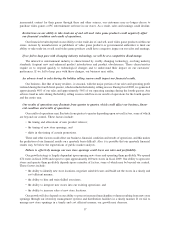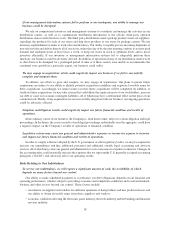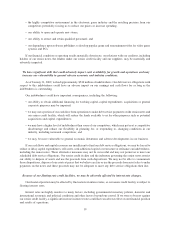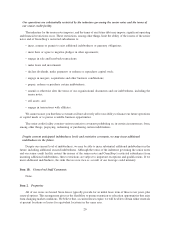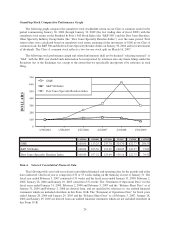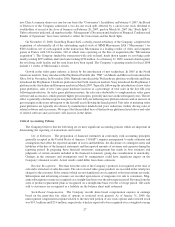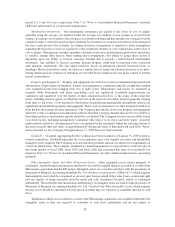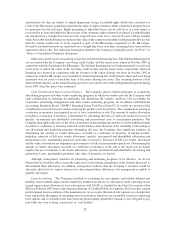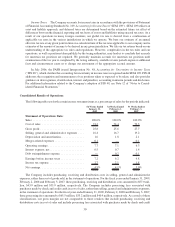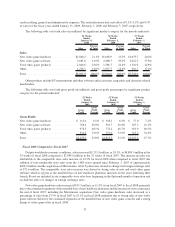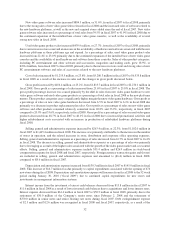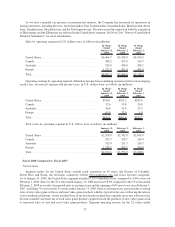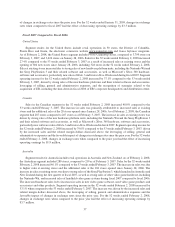GameStop 2008 Annual Report Download - page 42
Download and view the complete annual report
Please find page 42 of the 2008 GameStop annual report below. You can navigate through the pages in the report by either clicking on the pages listed below, or by using the keyword search tool below to find specific information within the annual report.into Class A common shares on a one-for-one basis (the “Conversion”). In addition, on February 9, 2007, the Board
of Directors of the Company authorized a two-for-one stock split, effected by a one-for-one stock dividend to
stockholders of record at the close of business on February 20, 2007, paid on March 16, 2007 (the “Stock Split”).
Unless otherwise indicated, all numbers in this “Management’s Discussion and Analysis of Financial Condition and
Results of Operations” have been restated to reflect the Conversion and the Stock Split.
On November 17, 2008, GameStop France SAS, a wholly-owned subsidiary of the Company, completed the
acquisition of substantially all of the outstanding capital stock of SFMI Micromania SAS (“Micromania”) for
$580.4 million, net of cash acquired in the transaction. Micromania is a leading retailer of video and computer
games in France with 332 locations, 328 of which were operating on the date of acquisition (the “Micromania
acquisition”). The Company funded the transaction with cash on hand, funds drawn against its revolving credit
facility totaling $275 million, and term loans totaling $150 million. As of January 31, 2009, amounts drawn against
the revolving credit facility and the term loans have been repaid. The Company’s operating results for fiscal 2008
include 11 weeks of Micromania’s results.
Growth in the video game industry is driven by the introduction of new technology. In 2005 in the North
American markets, Sony introduced the PlayStation Portable (the “PSP”) in March and Microsoft introduced the
Xbox 360 in November. In November 2006, Nintendo introduced the Wii hardware platform worldwide and Sony
introduced the PlayStation 3 hardware platform in the North American markets. Sony introduced the PlayStation 3
platform in the Australian and European markets in March 2007. Typically, following the introduction of new video
game platforms, sales of new video game hardware increase as a percentage of total sales in the first full year
following introduction. As video game platforms mature, the sales mix attributable to complementary video game
software and accessories, which generate higher gross margins, generally increases in the subsequent years. The net
effect is generally a decline in gross margins in the first full year following new platform releases and an increase in
gross margins in the years subsequent to the first full year following the launch period. Unit sales of maturing video
game platforms are typically also driven by manufacturer-funded retail price reductions, further driving sales of
related software and accessories. We expect that the installed base of the hardware platforms listed above and sales
of related software and accessories will increase in the future.
Critical Accounting Policies
The Company believes that the following are its most significant accounting policies which are important in
determining the reporting of transactions and events:
Use of Estimates. The preparation of financial statements in conformity with accounting principles
generally accepted in the United States of America (“GAAP”) requires management to make estimates and
assumptions that affect the reported amounts of assets and liabilities, the disclosure of contingent assets and
liabilities at the date of the financial statements and the reported amounts of revenues and expenses during the
reporting period. In preparing these financial statements, management has made its best estimates and
judgments of certain amounts included in the financial statements, giving due consideration to materiality.
Changes in the estimates and assumptions used by management could have significant impact on the
Company’s financial results. Actual results could differ from those estimates.
Revenue Recognition. Revenue from the sales of the Company’s products is recognized at the time of
sale and is stated net of sales discounts. The sales of used video game products are recorded at the retail price
charged to the customer. Sales returns (which are not significant) are recognized at the time returns are made.
Subscription and advertising revenues are recorded upon release of magazines for sale to consumers. Mag-
azine subscription revenue is recognized on a straight-line basis over the subscription period. Revenue from the
sales of product replacement plans is recognized on a straight-line basis over the coverage period. Gift cards
sold to customers are recognized as a liability on the balance sheet until redeemed.
Stock-Based Compensation. The Company records share-based compensation expense in earnings
based on the grant-date fair value of options or restricted stock granted. As of January 31, 2009, the
unrecognized compensation expense related to the unvested portion of our stock options and restricted stock
was $14.3 million and $23.4 million, respectively, which is expected to be recognized over a weighted average
27


